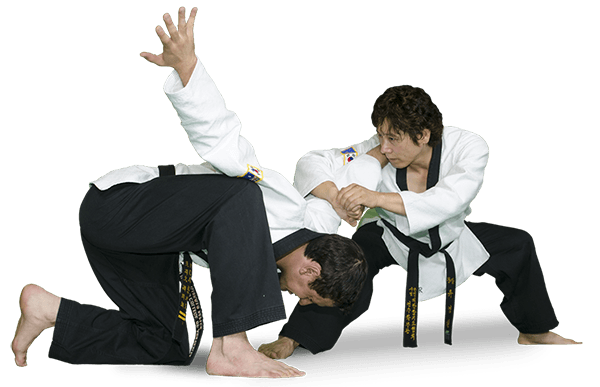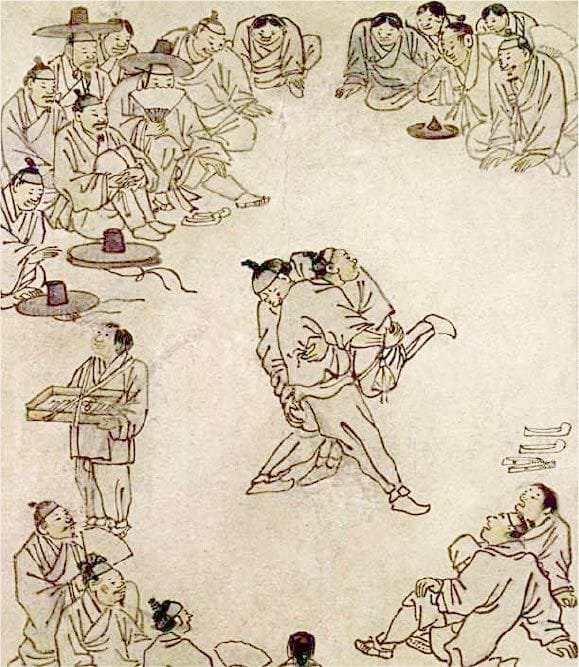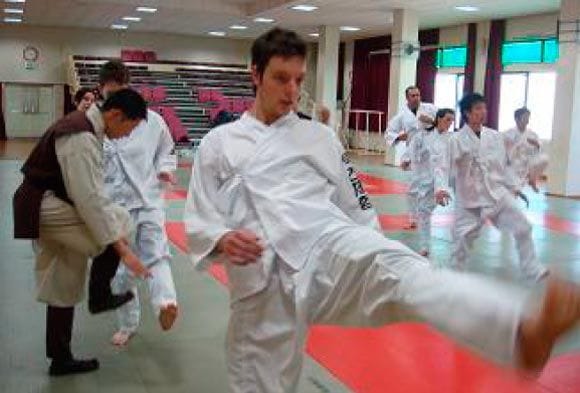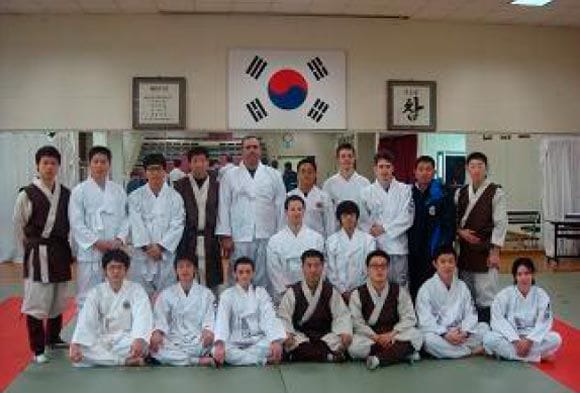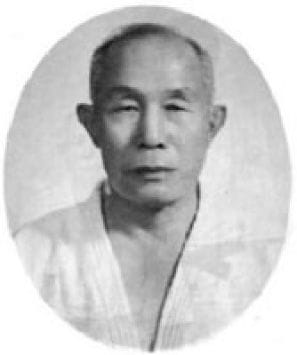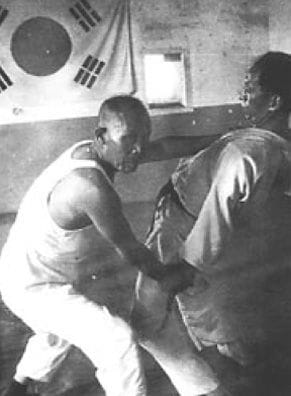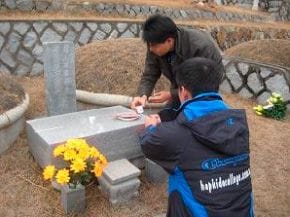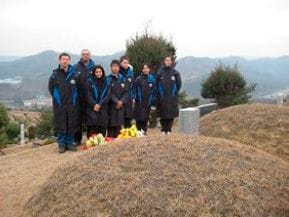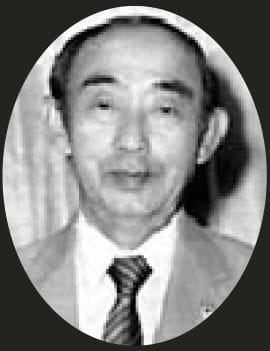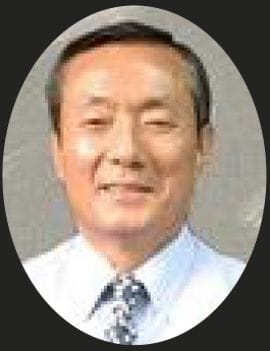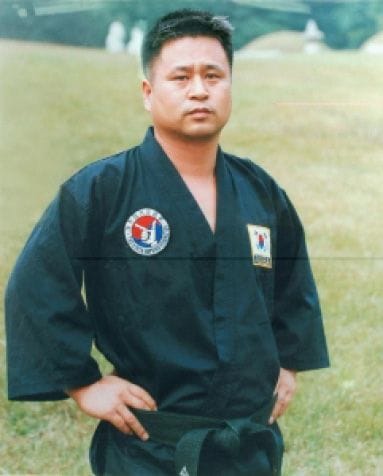The Innovation of Hapkido
Between the time Dojunim Yong Sul Choi taught his first lesson in 1948 up until the early 1960s, the Hapkido curriculum went through a period of innovation which completed it as a modern system. It is clear that the techniques of Yong Sul Choi make up the larger framework of techniques and ultimately the philosophy of the Hapkido curriculum with 3808 techniques set from Yong Sul Choi's teachings. However in addition to Daito-Ryu Aiki-Jujutsu that Yong Sul Choi learnt in Japan, it is also clear that some 150-200 additional striking techniques were influenced by native Korean arts such as Taekkyon. These innovations are credited to Dojunim Choi's early students.
Yong Sul Choi's most prominent early students were Suh Buk Sub, Ji Han Jae and Kim Moo Hong.
Ji Han Jae and Kim Moo Hong, previous to Hapkido had studied native Korean arts such as Taekkyon and contributed additional kicking innovations, greatly expanding Hapkido's foundation. Kim Moo Hong was promoted to 4th Degree by Suh Buk Sub before he left to live in isolation in a monastery where he spent years perfecting his kicking techniques. He then travelled to Seoul in 1961 and finalised the kicking curriculum with Ji Han Jae.
Ji Han Jae is a prominent pioneer of Hapkido, together with his physical skill, technical contribution, promotional efforts and political connections he is credited with popularising Hapkido through North America and Europe. He was the personal bodyguard to South Korean President Park Chung Hee (1962-1979) and has taught many Korean and US government and private law enforcement organisations including the US Military Special Forces, FBI and CIA. He also worked extensively in Hong Kong and Hollywood cinema as a trainer/actor and fight choreographer. He had appearances in the Fist of Unicorn 1972, Lady Kung Fu (Hapkido) 1972 and co-starred with Bruce Lee in his last feature film The Game of Death 1978. Bruce Lee was inspired by the techniques of Hapkido. Ji Han Jae taught Bruce Lee, who then went on to incorporate many of the techniques into his evolving style of Jeet Kune Do.
Ji Han Jae also helped form the Korea Hapkido Federation (KHF) in 1965 which has grown to become the largest federation in the world and is the only Hapkido organisation recognised by the South Korean government, setting the standards for Hapkido throughout the world. In 1980 Oh Sei Lim (pictured below and also featured in the video below) was elected president of the Korea Hapkido Federation and under his direction it has continued to flourish.
There are many other notable practitioners who, like their founder Dojunim Yong Sul Choi and his early students have dedicated their lives to the development of this complete martial art system around the world, teaching the general public as well as military and revolutionising Martial Arts in Hollywood and Hong Kong cinema. Grandmaster Hwang In Shik in particular trained many masters and celebrities such as Jackie Chan and Angela Mao, he also had appearances in Way of the Dragon1972, The Young Master 1980, Dragon Lord 1982 and more. Angela Mao was promoted to 3rd Dan by Grandmaster Hwang and starred in many films including the legendary Enter The Dragon 1973 with Bruce Lee.
The innovation of Hapkido has made it an eclectic martial art of extreme diversity with thousands of variations in technique that has influenced the birth of new modern day martial arts such as Kuk Sool Won (1950s), Hwarang Do (1960s), Tukong Mu Sool (1970s), Han Kido (1980s), Han Mu Do (1980s), Gong Kwon Yu Sool (1990s), Yong Mu Do (1990s) and Hapki Yu Sool (2000). As the unified arts such as Taekwondo and Judo have lost their flavour as martial arts and become sports like boxing, kickboxing and wrestling, Hapkido's technical nature has led to it being harder to unify which will retain it as a martial art for a very long time to come.Between the time Dojunim Yong Sul Choi taught his first lesson in 1948 up until the early 1960s, the Hapkido curriculum went through a period of innovation which completed it as a modern system. It is clear that the techniques of Yong Sul Choi make up the larger framework of techniques and ultimately the philosophy of the Hapkido curriculum with 3808 techniques set from Yong Sul Choi's teachings. However in addition to Daito-Ryu Aiki-Jujutsu that Yong Sul Choi learnt in Japan, it is also clear that some 150-200 additional striking techniques were influenced by native Korean arts such as Taekkyon. These innovations are credited to Dojunim Choi's early students.
Yong Sul Choi's most prominent early students were Suh Buk Sub, Ji Han Jae and Kim Moo Hong.
Ji Han Jae and Kim Moo Hong, previous to Hapkido had studied native Korean arts such as Taekkyon and contributed additional kicking innovations, greatly expanding Hapkido's foundation. Kim Moo Hong was promoted to 4th Degree by Suh Buk Sub before he left to live in isolation in a monastery where he spent years perfecting his kicking techniques. He then travelled to Seoul in 1961 and finalised the kicking curriculum with Ji Han Jae.
Ji Han Jae is a prominent pioneer of Hapkido, together with his physical skill, technical contribution, promotional efforts and political connections he is credited with popularising Hapkido through North America and Europe. He was the personal bodyguard to South Korean President Park Chung Hee (1962-1979) and has taught many Korean and US government and private law enforcement organisations including the US Military Special Forces, FBI and CIA. He also worked extensively in Hong Kong and Hollywood cinema as a trainer/actor and fight choreographer. He had appearances in the Fist of Unicorn 1972, Lady Kung Fu (Hapkido) 1972 and co-starred with Bruce Lee in his last feature film The Game of Death 1978. Bruce Lee was inspired by the techniques of Hapkido. Ji Han Jae taught Bruce Lee, who then went on to incorporate many of the techniques into his evolving style of Jeet Kune Do.
Ji Han Jae also helped form the Korea Hapkido Federation (KHF) in 1965 which has grown to become the largest federation in the world and is the only Hapkido organisation recognised by the South Korean government, setting the standards for Hapkido throughout the world. In 1980 Oh Sei Lim (pictured below and also featured in the video below) was elected president of the Korea Hapkido Federation and under his direction it has continued to flourish.
There are many other notable practitioners who, like their founder Dojunim Yong Sul Choi and his early students have dedicated their lives to the development of this complete martial art system around the world, teaching the general public as well as military and revolutionising Martial Arts in Hollywood and Hong Kong cinema. Grandmaster Hwang In Shik in particular trained many masters and celebrities such as Jackie Chan and Angela Mao, he also had appearances in Way of the Dragon1972, The Young Master 1980, Dragon Lord 1982 and more. Angela Mao was promoted to 3rd Dan by Grandmaster Hwang and starred in many films including the legendary Enter The Dragon 1973 with Bruce Lee.
The innovation of Hapkido has made it an eclectic martial art of extreme diversity with thousands of variations in technique that has influenced the birth of new modern day martial arts such as Kuk Sool Won (1950s), Hwarang Do (1960s), Tukong Mu Sool (1970s), Han Kido (1980s), Han Mu Do (1980s), Gong Kwon Yu Sool (1990s), Yong Mu Do (1990s) and Hapki Yu Sool (2000). As the unified arts such as Taekwondo and Judo have lost their flavour as martial arts and become sports like boxing, kickboxing and wrestling, Hapkido's technical nature has led to it being harder to unify which will retain it as a martial art for a very long time to come.

